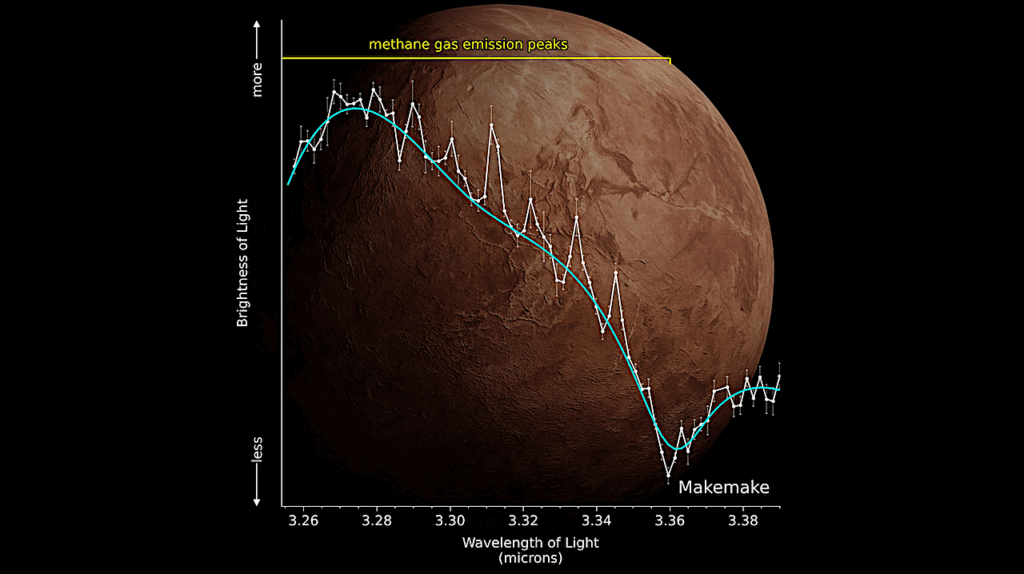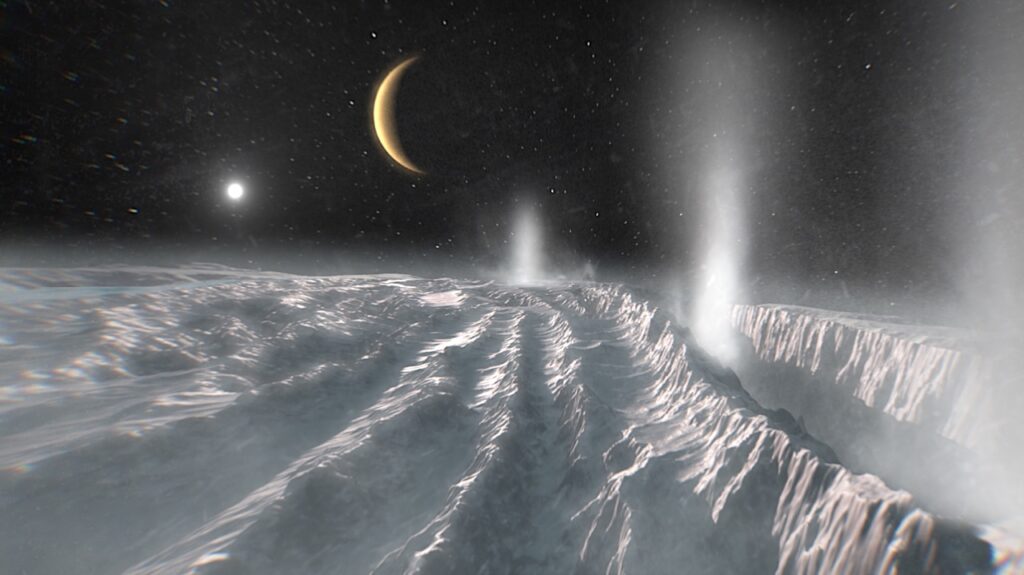The Importance of Plumes

The Hubble Space Telescope is famous for finding black holes. It can pick out thousands of galaxies in a patch of sky the size of a thumbprint. The most powerful space telescope ever built, the Hubble provided evidence that the Universe is slowing down in its infinite rush into whatever lies beyond.
But the Hubble’s cosmic firepower was recently put to a new purpose: searching for a billowing cloud of water vapor on Jupiter’s moon Europa. The plumes are a sign that extraterrestrial life could be lurking within our own Solar System. Before we head way out there, we need to know a little about the eruptions happening at home.
Plumes: Warm and Nearby
On Earth, the plumes are a hallmark of energy in motion. Here, active geology often takes the form of pyroclastic eruptions. Pyro is Greek for “fire,” while “clastic” derives from “broken.” Pyroclastic eruptions feature solid rock, semi-solid fragments and hot gases expelled from the mantle through areas of weakness in the crust.
They create the plumes of ash and smoke we typically associate with volcanos. Even when volcanos are underwater, as many are, they send up steaming columns of lava fragments, bits of rock and heated gas. These underwater plumes of hot material rise hundreds of meters. The heated underwater plumes that make it to the surface of the ocean can be seen from space.
While these displays are impressive, not all that explodes from the Earth’s crust is pyroclastic. Geysers are long columns of water. Their bases lie close enough to the mantle to be heated by its 1,000* C (1,832 * F) temperatures. The heated water expands and rises, forcing its way to the surface. Once the water and steam reach the surface, the pressure falls, as does the plume of vapor, after inertia shoots it briefly into space
In all of these formations, heated gases escape from the interior and reach the surface. There, they rapidly expand and cool, dissipating the fierce energies that drove them to erupt. In this way, volcanism reflects the build-up of pressure within a planet or other large body on which it is known to occur.
In March of 2006, geysers were discovered spewing water from the surface of Enceladus, one of Saturn’s icy moons. Thus began a race to explain how a moon with surface temperatures of -330* Fahrenheit (-201* Celsius) could have active geology, and to discover if those geysers could signal a warm core for Enceladus and other icy moons.
Plumes: Cold and Far Away
Cold cryoclastic plumes may play a key role in finding superhabitable zones in areas around gas giants where tidal forces create enough heat to sustain life. Nonetheless, they differ from traditional volcanism in many respects. One respect is temperature.
“Much of what we see taking place or see evidence of having taken place looks like lava and sort of normal volcanism on Earth except it involves warm water,” said Bruce Marsh, a geophysicist at the Department of Earth and Planetary Sciences, Johns Hopkins University.
Warm, in this case, is relative. Cassini, a NASA satellite, noticed that the area around these vents is substantially warmer than the surrounding ice: as high as -120* Fahrenheit (190 Kelvin). Where pyroclastic explosions emit fragments of broken fire, cryoclastic eruptions are bursts of icy material hundreds of degrees warmer than the surrounding surface, but still well below freezing.
Another point of difference between Earth’s plumes and icy world plumes is contents. Enceladus’ plumes spew water vapor and dust, which rapidly disperse into surrounding space. Then, there’s the point of origin. There are no volcanoes on Enceladus. Instead, these plumes originate from vents in the southern polar terrain, also known as “tiger stripes.” Now, at least two of the ingredients necessary for life are present on Enceladus: water and warmth.
Unfortunately, the existence of relatively warm vents and escaping water are insufficient to prove that active heating is occurring deep within the moon, or that an ocean lies within its ice sheet. Local radioactivity and flexing forces from Saturn may be creating underground liquid reservoirs in the regions around the vents. That would raise temperature in just that region, melting ice that could then pool into the cracks. If this were true, water vapor plumes on Enceladus might originate relatively near the surface, instead of from a life-breeding ocean.
The discovery of the plume on Enceladus was sufficient to prove that icy moons undergoing tidal forces are geologically active. It was a good sign that we should look for others.
As it happens, there is another icy moon, namely Europa, circling a closer planet, that has all of ingredients for life as well. It also has an extremely thick ice sheet, a saltwater signature and possibly an enormous ocean with twice as much water as all of the oceans on Earth combined. Organic material has been found on the surface. The surface itself is known to undergo continual remodeling, bringing organics down and any subsurface life-signatures up. Many scientists believed that if plumes could be found on Europa, that would be a portent that we should head there to look for further signs of life.
Until recently, though, none had been seen. It turns out that finding a geyser 500,000 miles away is tricky business. How the Hubble happened to be looking right at Europa the moment a plume exploded is more than pure coincidence.
Pretty Elusive Eruptions
“Plumes on Europa could be tough to catch in the act,” said Lynnae Quick, a planetary scientist and postdoctoral fellow at NASA’s Goddard Institute of Space Studies. “If observing at visible wavelengths, there have to be enough particles (in the plume) in order for it to be seen. Icy satellites (like Europa and Enceladus) have very bright, reflective surfaces. The light reflected off of these surfaces can obscure plumes from being seen. For this reason, you want to look at the limb.”
Looking at the limb of a planetary body requires a perpendicular point of view. It’s not a natural viewpoint for humans. We tend to look straight an object of interest, focusing on the center of it.
Imagine examining a tree. The natural thing to do is to look directly at the trunk. The limbs of a tree are everywhere, scattered in all directions at the periphery of your visual field. The tiniest tree limbs are nearly impossible to see without standing close to the tree and craning your neck. In the case of Europa, standing close isn’t an option. That’s one reason a really big telescope is needed.
Considering the tree analogy, another problem becomes obvious: tree limbs are only visible against a different-colored background, like a blue sky or white clouds. Europa’s surface is made of water. The plumes are too.
“On Europa, plumes are very hard to see because you are putting ice crystals on top of an icy surface,” said Louise Prockter, a superviser at Johns Hopkins University’s Applied Physics Laboratory’s planetary exploration group.
Looking at the limb of Europa, where the edge of the moon meets the dark space of space gives is like dropping a black curtain in the background. That’s a better contrast than the white ice. However, there’s another problem.
“The problem with [water] plumes is that they are very tenuous,” said Prockter, “We’ve seen plumes off the limb of Io (Jupiter’s innermost Galilean moon) because they tend to be pretty fierce and pretty long lasting. They caused massive changes on the surface on the time scale that Galileo was there.”
On smaller Enceladus, plumes remain suspended for a time. By contrast, the expulsion of water vapor into the near-vacuum surrounding Europa is short-lived. Europa’s more substantial gravity yanks the frozen water spouts back toward the surface. Ice lands on ice, leaving barely a trace. So the only chance to catch a plume on Europa is to look at the disc and the limb, and keep looking until one happens right in front of us.
The Hubble Space Telescope is currently the only tool powerful enough to crane its neck at just the right angle to catch a transient puff of the water vapor 400 million miles away. Even so, Hubble hunted for a plume on Europa for years without success. It was aimed at Europa in October 1999, November 2012 and December 2012 before finally catching one using its spectrograph.
Caught on Camera in Invisible Light
A spectrograph is an instrument that separates light into color components by wavelength. Spectrographs are invaluable instruments in astronomy. Objects in space that can’t be seen with visible light can still be detected by the radiation around them. Hubble’s Space Telescope Imaging Spectrograph (STIS) allows it to detect black holes. In Europa’s case, the STIS picked up the plume’s vapor cloud by its ultraviolet light, which is just beyond what’s visible to the eye.
In the ultraviolet spectrum, the plume of water vapor seen by Hubble Space Telescope in December 2012 extended more than 125 miles (200 kilometers) into space.
“I’m really excited about these observations because they seem to suggest that some areas of Europa’s crust are being intensely heated to create the vapor,” said Jason Goodman, assistant professor of physics at Wheaton college, who has published research on hydrothermal plumes on Europa. “We can’t say for sure yet whether this is a cyclical process or a chance event, or whether the vapor is coming from warm but solid ice, partially-melted ice, or from the ocean, but it’s definitely a sign that Europa has some exciting internal activity going on right now.”
Putting On the Gloves
Even with the Hubble Space Telescope hard at work, we are uncertain how water gets just below the surface of Europa. We have many models about how, and quite a few notions about when. For example, at the farthest point, or apocenter, Europa experiences tensions that may cause plume production at weak spots in the ice.
“At apocenter, the surface fractures in the south polar region experience tension. This tension might open the cracks and allow the water vapor to escape from a subsurface liquid reservoir,” said Lorenz Roth, first author on the Science paper that described the plume’s discovery. “Confirmation of the initial detection and the proposed connection to Europa’s orbital position is crucial now.”
Using Hubble to look for further plumes during the entire orbit will bring us closer to some answers. However, we won’t truly understand what’s going on inside Europa’s salty oceans, possibly warm for the last 4 billion years, until we take a much, much closer look.
“More Hubble data will help,” said Goodman. “But this vapor plume is right at the limit of what telescopes near Earth can see. To really get to the bottom of this story, we need to send a spacecraft to Europa.”
With plumes, water vapor bursts through the ice shell and arches away at amazing speed. The resulting ballistic arc of freezing droplets can be seen from half a million miles away. Better still, they can be sampled without having to land, drill, melt or dig.
“What this means is that we can now go and sample the subsurface by flying through a plume,” said Prockter. “There’s a very good chance that we can sample the material in five to 10 or 15 years.”
Now that we know when and where Europa is active, a mission can be launched with plumes specifically in mind.
“A spacecraft in a low enough orbit could fly through the plume,” said Quick.
A plume is a million pieces of Europa’s interior. These pieces might be from the depths of the sea or from just below the surface. Either way, to reach into the ice of a faraway moon, all we have to do is catch a plume.
“That’s really exciting. Europa comes to us,” said Prockter. “I can’t think of anywhere better for life than Europa.”
Sheyna E. Gifford, MD , Astrobiology Magazine








